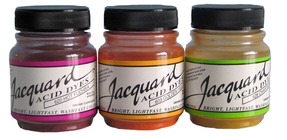Fabric Dye Buyer’s Guide to Discover How to Choose Which Fabric Dye is Best for Your Project
Author: Cheryl Kilbourne-Kimpton
One of the most frequent questions asked here at the store is “What’s the difference between fabric dyes?” With so many dyes to choose from: RIT, Dylon, iDye , Procion MX, jacquard Acid and the chemicals that need to be used with them it can be confusing. Wardrobe Professionals and Professional Costumers know to decide what dye to use, you answer these three questions:
- what is the fabric made of?
- how vibrant do you want the color?
- how are you going to dye it?
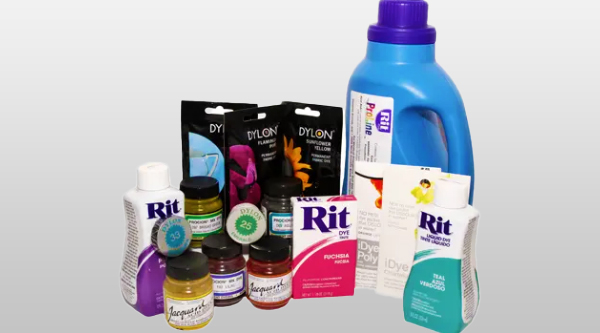 What Kinds of Dyes Are There?
What Kinds of Dyes Are There?
Fiber Reactive Dyes, such as Procion MX by Jacquard have superior colorfastness. They are great for cellulose fibers such as cotton, linen, rayon, raime and viscose rayon . You need a few extra items for Fiber Reactive dyes however such as soda ash , salt and Synthrapol . Soda Ash bonds the dye to the fiber, salt helps to fix the dye and Synthrapol is used as a pre-wash to remove any dirt, grease or sizing from your fiber and as a post dye rinse to remove excess dye. Fiber reactive dyes also work best at room or lukewarm temperatures. If you’d like to use fiber reactive dyes on silk and wool, you will need to add white vinegar (acetic acid) and simmer the fabric in the dye bath in order to get the correct color.
- Works on: Cotton, linen, rayon, raime, and viscose rayon fabric (silk and wool with an acidic dyebath)
- Benefits of Procion MX: amazing colorfastness
- Chemical Assistants: requires Soda Ash, salt, Synthrapol
Acid Dyes, such as Jacquard Acid dyes are concentrated, powdered, hot water dyes that yield the most vibrant results possible for protein fibers such as silk and wool. They also work on nylon, Lycra, acid-dyeable acrylics and both human and yak hair for wig making. Acetic acid (white vinegar) is used as a chemical assistant. As with Procion MX , Synthrapol is useful as a post rinse. When immersion dyeing, Jacquard’s Acid Dyes produce a uniform color, which is always a challenge for dyers. The colors are beautiful, extremely brilliant and colorfast. Acid dyes are used at a hot temperature (around 205 F), and you have to be careful with both wool and silk, as the fabrics can degrade at too high a temperature. They can also be used to paint silk, wool or nylon in addition to dyeing. If you are dyeing wool, a gradual heating and gradual cooling of the dyebath is important so as not to shock and felt the wool.
- Works on: Silk, wool, nylon, Lycra, acid-dyeable acrylics, some hairs.
- Benefits of Jacquard Acid: Brilliant color, and can be used to paint in addition to dying
- Drawbacks: requires high heat for dying.
- Chemical Assistants: Vinegar (acetic acid) Synthrapol
Union Dyes, such as RIT, Dylon Multipurpose and Dylon Permanent are “Universal” dyes that allow you to dye a variety of fabrics. If you are in the market for a quick, easy dye- union dyes are for you. Even professional theater dyers use them because they’re so versatile. While union dyes will dye many fabrics, the colors will be less brilliant, and less colorfast. They only require salt to “fix” the dye. Even though there are a few downsides to union dyes, their advantages make them popular: they come in both liquid and powder form, need very little special equipment, and come in a variety of colors. For larger items, you can even use your washer as the dye bath container, which eliminates a lot of the mess associated with home dyeing.
- Works on: celluslose fibers and protein fibers
- Benefits of RIT and Dylon: easy to obtain, require no additional materials or complicated dying methods
- Drawbacks: less intense colors, less colorfast than other methods
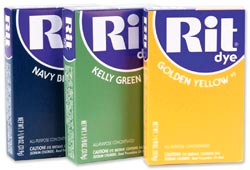
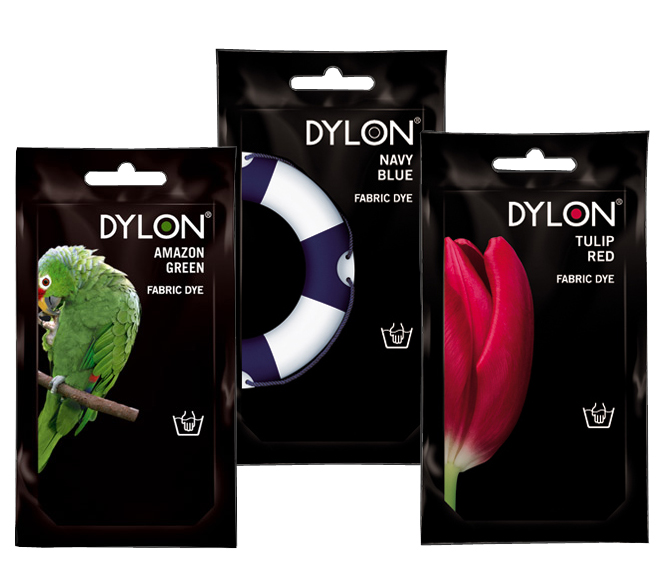

Direct Dyes like iDye by Jacquard behave like a union dye in that they don’t have great colorfastness, but require hot water, salt and in some cases vinegar. In the case of iDye, it comes in a dissolvable packet, so you simply drop the packet into hot water or toss it in your washer.
- Works on: natural fabrics such as cotton silk, wool, linen and rayon.
- Benefits: dissolvable packet. Can be used on the stovetop or in washing machine.
- Chemical Assistant: needs salt or vinegar depending on fabric type (vinegar for protein fibers)
- Drawbacks: diminished colorfastness, difficult to mix colors due to the dissolvable packet
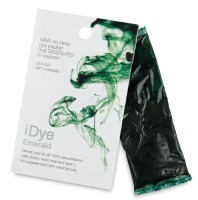
Disperse Dyes like iDye Poly are specifically for polyester and nylon fabrics. This dye requires the hottest dyebath.
- Works on: synthetic fibers such as polyester and nylon, and some plastics.
- Benefits: easy to use dissolvable packet
- Chemical Assistant: needs color intensifier, which is in the package
- Drawbacks: Only 16 colors available,requires more heat than other dyes, difficult to mix colors due to dissolvable packet
- note: For blended fabrics containing both synthetic and natural fibers, use iDye for Natural Fabrics with the corresponding iDye Poly color AT THE SAME TIME! (Or, for more interesting, two-tone, heather effects, try pairing two different colors.)
Choosing Fabric Dye Based On Your Fabric
- Cotton, linen, rayon, raime and viscose rayon: Procion MX, RIT ,Dylon or iDye for Natural Fabrics
- Silk, wool, nylon, Lycra, acid-dyeable acrylics, human hair, yak hair: Jacquard Acid, RIT , Dylon and idye Poly for nylon
- Polyester: iDye Poly
- Acrylic and wool blends: acid dyes (Jacquard Acid) will color both the acrylic and the wool.
- Silk and linen blends: fiber-reactive dye (Procion MX) in one bath, and a subsequent bath in an acid dye (Jacquard Acid). You can use a union dye (RIT or Dylon) or iDye for Natural fabrics instead, but the color won’t be as intense.
- Cotton and spandex: fiber-reactive dyes (Procion MX) to guarantee the color will last through washing.
- Blended fabrics with both synthetic and natural fibers: use iDye Poly and corresponding iDye Natural at the same time.
- Wool: Jacquard Acid, but remember a gradual heating and gradual cooling of the dyebath is important so as not to shock and felt the wool.
Choosing Fabric Dye Based On Colorfastness
RIT , Dylon (union dyes) and iDye are going to be less vibrant and colorfast than Procion MX and Jacquard Acid.
Choosing Fabric Dye Based On Dying Method
How are you going to use the dye? Tub dying? Painting? Batik? Tie-Dye? Are you using it yourself or with kids?
- Tie-Dye: Dylon and RIT dye offer non toxic ease of use, and an inexpensive way to get a wide range of colors
- Painting: Procion MX, Jacquard Acid.
- Batik: Procion MX, Jacquard Acid. There is a non-wax batik method for RIT, but will result in less brilliant colors.
- Tub dying: RIT, Dylon and iDye for Natural Fabrics don’t require heat and can be used in either a tub or your washer.
- Heather effect: use different colors of iDye Poly and iDye Natural on blended fabrics for a two tone effect.
- Working with Kids: RIT, Dylon and iDye for Natural Fabrics both are non toxic and due to their ease of use are recommended over counterparts for working with kids.
We’re excited to bring you more articles and tutorials on how to use our dyes in the future. Don’t forget: you can buy Procion MX, Jacquard Acid, RIT, Dylon, iDye, soda ash, Synthrapol and everything you need from Manhattan Wardrobe Supply for fabric dye at your home.
screen”>

